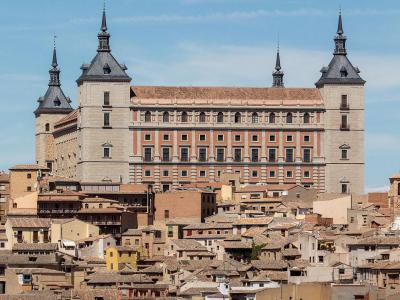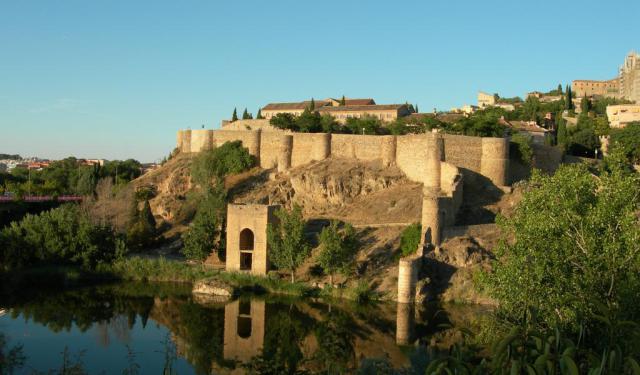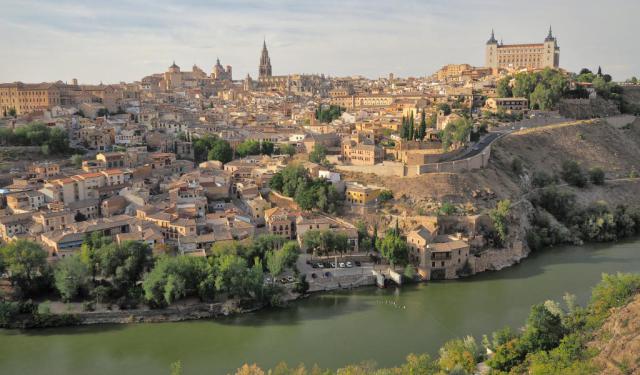
Alcazar Fortress, Toledo (must see)
Jose Moscardo Ituarte, Military governor of the province of Toledo, was on the phone. It was July 23d, 1936. Moscardo's command post, the Alcazar Fortress, was under siege by Republican forces. He was talking to his son, Luis, a prisoner of the Republicans. The besieging enemy would spare Luis' life if Alcazar surrendered.
"Commend your soul to God." He told his son, "shouting 'Long live Christ, King!' and 'Long live Spain!'" The Alcazar held out, and Luis was killed. The siege ended with the arrival of Nationalist relief forces on September 27th. The merciless Civil War made Alcazar a symbol of Spanish Nationalism. Heavily damaged, the fortress was rebuilt.
"Alcazar" is derived from the Arabic word for castle. Originally a Roman Palace in the 3rd century, it was restored in the 1540s by Charles I and his son, Philip II of Spain. Today it is home to the Castilla-La Mancha Regional Library and the Museum of the Army ("Museo del Ejercito").
The fortress sits firmly on the highest elevation in the city, dominating all around it. Its facades are Renaissance in style. It is rectangular, four-sided, with crenelated defense walls and turreted towers at each corner, according to a preliminary design by Alonso de Covarrubias, subsequently completed by Juan de Herrera.
The fortress is open from 11 am to 5 pm every day.
"Commend your soul to God." He told his son, "shouting 'Long live Christ, King!' and 'Long live Spain!'" The Alcazar held out, and Luis was killed. The siege ended with the arrival of Nationalist relief forces on September 27th. The merciless Civil War made Alcazar a symbol of Spanish Nationalism. Heavily damaged, the fortress was rebuilt.
"Alcazar" is derived from the Arabic word for castle. Originally a Roman Palace in the 3rd century, it was restored in the 1540s by Charles I and his son, Philip II of Spain. Today it is home to the Castilla-La Mancha Regional Library and the Museum of the Army ("Museo del Ejercito").
The fortress sits firmly on the highest elevation in the city, dominating all around it. Its facades are Renaissance in style. It is rectangular, four-sided, with crenelated defense walls and turreted towers at each corner, according to a preliminary design by Alonso de Covarrubias, subsequently completed by Juan de Herrera.
The fortress is open from 11 am to 5 pm every day.
Want to visit this sight? Check out these Self-Guided Walking Tours in Toledo. Alternatively, you can download the mobile app "GPSmyCity: Walks in 1K+ Cities" from Apple App Store or Google Play Store. The app turns your mobile device to a personal tour guide and it works offline, so no data plan is needed when traveling abroad.
Alcazar Fortress on Map
Sight Name: Alcazar Fortress
Sight Location: Toledo, Spain (See walking tours in Toledo)
Sight Type: Attraction/Landmark
Guide(s) Containing This Sight:
Sight Location: Toledo, Spain (See walking tours in Toledo)
Sight Type: Attraction/Landmark
Guide(s) Containing This Sight:
Walking Tours in Toledo, Spain
Create Your Own Walk in Toledo
Creating your own self-guided walk in Toledo is easy and fun. Choose the city attractions that you want to see and a walk route map will be created just for you. You can even set your hotel as the start point of the walk.
El Greco's Masterpieces
Domnnikos Theotokopoulos, most widely known as El Greco or "The Greek," was a Greek painter, sculptor, and architect of the Spanish Renaissance. El Greco was well ahead of his time. His dramatic and expressionistic style is regarded as a precursor of both Expressionism and Cubism of the 20th century.
El Greco was born in Crete, Greece, and studied painting in Italy. In 1577, he... view more
Tour Duration: 1 Hour(s)
Travel Distance: 2.0 Km or 1.2 Miles
El Greco was born in Crete, Greece, and studied painting in Italy. In 1577, he... view more
Tour Duration: 1 Hour(s)
Travel Distance: 2.0 Km or 1.2 Miles
Toledo's Ancient Walls, Gates and Bridges
Other than its signature “Toledo steel”, the Spanish city of Toledo is known for its historic architecture, particularly the ancient mammoth fortifications – a testament to the strength of the city that has maintained its borders for well over a thousand years.
Toledo's soaring walls were first built by the Romans in the 3rd century AD and then further expanded, over the following... view more
Tour Duration: 1 Hour(s)
Travel Distance: 2.1 Km or 1.3 Miles
Toledo's soaring walls were first built by the Romans in the 3rd century AD and then further expanded, over the following... view more
Tour Duration: 1 Hour(s)
Travel Distance: 2.1 Km or 1.3 Miles
Toledo Introduction Walking Tour
Located on the banks of the Tagus River in Spain, Toledo is called the "City of the Three Cultures." The cultures would be Christianity, Islam, and Judaism. They didn't always get along, but each has left its mark. Romans visited the area as early as 193 BC. Roman historian Livy referred to the city as "a small city, but fortified by location."
In 546, the early... view more
Tour Duration: 2 Hour(s)
Travel Distance: 3.2 Km or 2 Miles
In 546, the early... view more
Tour Duration: 2 Hour(s)
Travel Distance: 3.2 Km or 2 Miles



